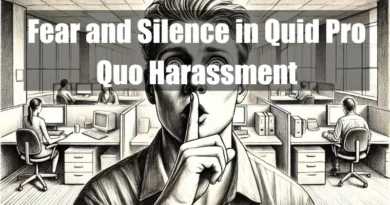Explaining Bystanders vs. Quid Pro Quo Harassment
Takeaways
| Key Points |
|---|
| Quid Pro Quo harassment occurs when someone in a position of power demands sexual favors in exchange for job benefits or threatens negative consequences for refusal, making it a serious workplace issue. |
| Bystanders—those who witness or become aware of such harassment—can play a crucial role in proving these cases by providing testimony, collecting evidence, and supporting the victim, though they may face legal hurdles and fears of retaliation. |
| Under laws like Title VII of the Civil Rights Act of 1964, bystanders who report harassment are protected from retaliation, but their testimony must be credible and well-documented, including details such as dates, direct quotes, and any supporting evidence like emails or texts. |
| Reporting options include internal channels like HR, external regulatory bodies like the EEOC, and anonymous mechanisms, though anonymous reports may limit investigations. |
| Bystander intervention programs help educate employees on recognizing and responding to harassment, encouraging a culture where misconduct is less tolerated and reducing incidents by making potential harassers aware that their actions are being observed. |
Introduction
Quid Pro Quo harassment occurs when an individual in a position of power demands sexual favors in exchange for job benefits or threatens job detriments for non-compliance. It is a serious issue that impacts both victims and the broader workplace environment. While the victim is the primary target, bystanders—those who witness or become aware of such harassment—can play an important role in addressing and proving these cases. Bystanders are often overlooked in the discourse surrounding harassment, yet their involvement can be instrumental in bringing about justice.

The importance of bystanders in proving harassment cases lies in their potential to provide credible evidence and support for the victim. Their testimony can validate the victim’s claims, provide additional perspectives on the incident, and help create a workplace culture that does not tolerate harassment.
Legal Standing of Bystanders in Quid Pro Quo Harassment Cases
Understanding Bystander Rights in Employment Law
Bystanders in harassment cases are not passive observers; they may have protections under employment law, especially against retaliation for reporting or supporting a harassment claim. While laws primarily focus on protecting the victim, bystanders are often protected under the same laws if they experience retaliation for reporting or supporting a harassment claim. Under Title VII of the Civil Rights Act of 1964 in the United States, bystanders who report harassment are protected against retaliation, meaning employers cannot legally punish them for speaking up.
Key Legal Precedents Involving Bystanders in Harassment Cases
Legal precedents have recognized the role of bystanders in harassment cases, particularly when their testimony supports the victim’s claims or corroborates key aspects of the incident. Courts have acknowledged the value of bystanders, especially those who report harassment or support the victim, though their impact may vary depending on the evidence presented and the specifics of each case.
In some cases, the testimony of a bystander has been pivotal in corroborating the victim’s account and ensuring a fair judgment. For instance, the Faragher v. City of Boca Raton case highlighted the importance of the workplace environment and the role of witnesses in shaping that environment.
Identifying Quid Pro Quo Harassment as a Bystander
Signs and Indicators of Quid Pro Quo Harassment in the Workplace
Bystanders may recognize Quid Pro Quo harassment through various signs. These can include overt requests for sexual favors in exchange for job benefits or more subtle forms of coercion, such as threats to job security if the demands are not met. Other indicators might include changes in the victim’s behavior, such as sudden fear of a superior, unexplained demotions, or unwarranted disciplinary actions following a refusal to comply with inappropriate demands.

Common Scenarios Where Bystanders Might Witness Harassment
Bystanders might witness quid pro quo harassment in several scenarios, such as during private meetings between a supervisor and an employee, casual workplace conversations, or emails and text messages. Often, bystanders may notice something amiss in the interactions between the harasser and the victim but may be unsure if it constitutes harassment. In some cases, they might overhear or witness direct solicitations or threats.
Documenting Evidence as a Bystander

Best Practices for Recording Incidents: What, When, and How to Document
Documenting incidents of harassment is crucial for bystanders. They should note the date, time, location, and nature of the incident as soon as possible after it occurs. Detailed notes should include direct quotes, descriptions of the events, and the context in which the harassment occurred. This documentation should be factual, avoiding personal opinions or assumptions.
Gathering Supporting Evidence: Emails, Texts, Witness Testimonies
Bystanders should collect any physical evidence, such as emails or text messages, that support the victim’s claims. If other colleagues have witnessed similar behavior, bystanders can also encourage them to document their observations. Multiple testimonies can strengthen the case and provide a more comprehensive picture of the harassment.
Ensuring the Accuracy and Reliability of Collected Evidence
The evidence collected by bystanders must be accurate and reliable. Bystanders should avoid altering or exaggerating the facts, as this can undermine the credibility of the evidence. Keeping records in a secure place and ensuring that they are only shared with trusted individuals or authorities is also important for maintaining the integrity of the documentation.
Reporting Quid Pro Quo Harassment as a Bystander

Internal Reporting Channels: Navigating Corporate Policies
Bystanders should first consider reporting the harassment through internal channels, such as human resources (HR) departments or dedicated reporting systems. Familiarity with the company’s anti-harassment policies is crucial, as it provides a clear understanding of the procedures and protections available.
External Reporting: Engaging Legal Authorities and Regulatory Bodies
If internal reporting does not lead to action, or if the company is complicit, bystanders may need to report the harassment to external authorities. These can include regulatory bodies like the Equal Employment Opportunity Commission (EEOC) in the United States or similar entities in other countries. These organizations are equipped to handle harassment complaints and can provide legal guidance and support.
Anonymous Reporting: Safeguards and Legal Protections for Bystanders
For bystanders who fear retaliation, anonymous reporting might be a safer option. Many organizations have mechanisms in place to allow employees to report harassment anonymously, which can provide legal protections while still ensuring that the issue is addressed. However, bystanders should be aware that anonymous reports might limit the investigation’s scope, as it can be more challenging to corroborate facts without a named source.
Bystander’s Role in Strengthening the Case

How to Support the Victim in Building a Strong Case
Bystanders can play a crucial role in supporting the victim by offering to be witnesses, helping to document incidents, or simply providing emotional support. Their involvement can lend credibility to the victim’s claims and demonstrate to the harasser that their actions are being monitored.
Providing Emotional and Legal Support to the Harassment Victim
Beyond the legal aspects, bystanders can offer emotional support to victims by listening to their experiences, validating their feelings, and encouraging them to seek help. Legal support might involve helping the victim find a lawyer or accompanying them to meetings with HR or legal authorities.
By standing with the victim, bystanders help to create a culture where harassment is less likely to thrive.
Challenges Faced by Bystanders in Proving Harassment

Legal Hurdles in Bystander Testimonies
Bystanders often encounter legal challenges when providing testimony in quid pro quo harassment cases. Courts may question the credibility of their accounts, scrutinizing whether their testimonies are unbiased. Additionally, the requirement for concrete evidence can be a significant obstacle, particularly when bystanders witness only parts of incidents or when the harassment is subtle.
Bystanders might struggle to differentiate between actionable harassment and less severe workplace interactions, especially since quid pro quo harassment often occurs privately. This makes it challenging to provide a comprehensive account of events, further complicating the legal process.
Addressing Retaliation Concerns for Bystanders
The fear of retaliation is a major concern for bystanders. Despite legal protections, many fear backlash from employers or colleagues if they report harassment or support the victim. Retaliation can manifest as demotions, exclusion from work opportunities, or even termination. This fear often discourages bystanders from coming forward, complicating the process of proving harassment.
Organizations must implement robust anti-retaliation policies to combat these concerns, providing a safe environment for bystanders to report misconduct. Legal recourse, such as filing a retaliation claim under Title VII, is also available for those who face repercussions after reporting harassment.
Overcoming Challenges in the Absence of Direct Evidence
Bystanders may lack direct evidence of harassment, relying instead on observations or suspicions. Overcoming this challenge requires a strategic approach, such as encouraging other witnesses to step forward or identifying patterns in the harasser’s behavior and documenting circumstantial evidence, like changes in the victim’s behavior or retaliatory actions following a refusal of the harasser’s demands.
Legal frameworks often consider the totality of circumstances, meaning that even indirect evidence can support the victim’s claims.
Bystander Intervention Programs and Their Impact

Overview of Effective Bystander Training Programs
Bystander intervention programs are critical in educating employees on recognizing and responding to harassment. These programs teach bystanders to identify signs of quid pro quo harassment, provide tools for safe intervention, and encourage proactive reporting. Programs like “Step Up” and “Green Dot” empower bystanders to take action, often using role-playing to prepare participants for real-life situations.
These programs emphasize the importance of a supportive environment where all employees feel responsible for maintaining a harassment-free workplace. By fostering a sense of collective responsibility, these programs can significantly reduce harassment incidents in the workplace.
Real-Life Impact of Bystander Interventions on Quid Pro Quo Harassment Cases
Bystander interventions can significantly impact harassment cases. Documented instances show that bystander involvement can contribute to the resolution of complaints and help strengthen workplace policies, although success often depends on organizational response and support. In workplaces with active bystander intervention programs, there is often a noticeable decrease in harassment incidents, as potential harassers are aware that their actions are being monitored.
Furthermore, bystander interventions can shift workplace culture from silence and complicity to vigilance and accountability, which are crucial in preventing harassment and ensuring that victims feel supported.
Conclusion
Bystanders are essential in addressing quid pro quo harassment. Their role in identifying, documenting, and reporting harassment can significantly influence the outcome of a case. Despite challenges like legal hurdles and fear of retaliation, bystander involvement is crucial for creating a harassment-free workplace.
Effective bystander intervention programs and a supportive organizational culture empower bystanders to act, making them a powerful force against harassment. The combined efforts of bystanders, victims, and organizations can lead to a safer, more equitable workplace.
FAQ
What is the legal definition of quid pro quo harassment?
Quid pro quo harassment occurs when submission to or rejection of unwelcome sexual conduct is used as the basis for employment decisions affecting the individual. This form of harassment is prohibited under Title VII of the Civil Rights Act of 1964.
Who qualifies as a bystander in the context of workplace harassment?
A bystander is an individual who observes or becomes aware of behavior that may constitute harassment but is not directly involved as a victim or perpetrator. Bystanders can be colleagues, supervisors, or any personnel present in the workplace.
Are bystanders legally obligated to report observed quid pro quo harassment?
While federal law does not impose a general duty on bystanders to report harassment, certain jurisdictions and organizational policies may require reporting, especially for individuals in supervisory roles. Failure to report can lead to ethical or professional consequences.
What legal protections exist for bystanders who report quid pro quo harassment?
Bystanders who report harassment in good faith are generally protected from retaliation under Title VII of the Civil Rights Act. This protection encourages individuals to report misconduct without fear of adverse consequences.
Can a bystander be held liable for not intervening in quid pro quo harassment?
While bystanders are not typically held liable for failing to intervene, those in supervisory positions may face consequences if they neglect their duty to address known harassment. Employers can be held vicariously liable if they fail to take reasonable steps to prevent or correct harassment.
How can a bystander effectively document evidence of quid pro quo harassment?
Bystanders should record details such as dates, times, locations, involved parties, and specific behaviors observed. Collecting supporting evidence like emails, messages, or witness statements can strengthen the report’s credibility.
What is the role of a bystander in investigating quid pro quo harassment?
Bystanders may serve as witnesses, providing testimony and evidence to support the investigation. Their accounts can corroborate the victim’s claims and contribute to a comprehensive understanding of the incident.
Are there legal precedents involving bystanders in quid pro quo harassment cases?
Yes, legal precedents have recognized the significance of bystander testimony in harassment cases. Courts have considered bystander accounts to establish behavior patterns and assess the credibility of allegations.
What challenges might a bystander face when reporting quid pro quo harassment?
Bystanders may encounter challenges such as fear of retaliation, uncertainty about the incident details, or concerns about becoming involved in legal proceedings. Organizations should provide support to address these concerns.
How does bystander intervention impact the outcome of quid pro quo harassment cases?
Active bystander intervention can lead to earlier detection and resolution of harassment issues, potentially preventing escalation. Bystander reports can provide critical evidence, thereby influencing the outcome of cases.
What is vicarious liability, and how does it relate to bystanders in harassment cases?
Vicarious liability refers to an employer’s legal responsibility for the actions of its employees performed within the scope of employment. While bystanders themselves are not typically subject to vicarious liability, their failure to report observed harassment can contribute to an employer’s liability if it is shown that the employer knew or should have known about the harassment and failed to act.
Can a bystander’s failure to report harassment affect an employer’s liability?
Yes, if a bystander, especially one in a supervisory role, fails to report known harassment, it can be argued that the employer had constructive knowledge of the misconduct. This can impact the employer’s liability in legal proceedings.
What is the “reasonable person” standard, and how does it apply to bystanders?
The “reasonable person” standard is a legal benchmark used to determine how an average person would responsibly act in a given situation. In the context of bystanders, it assesses whether a typical person in similar circumstances would have recognized and reported the harassment.
Are there specific training programs for bystanders to handle quid pro quo harassment?
Many organizations implement bystander intervention training programs designed to educate employees on recognizing harassment and taking appropriate action. These programs aim to empower bystanders to intervene safely and effectively.
How can organizations encourage bystander reporting of quid pro quo harassment?
Organizations can foster a culture of accountability by establishing clear anti-harassment policies, providing regular training, ensuring confidential reporting mechanisms, and protecting individuals from retaliation. Encouraging open communication and support can also motivate bystanders to report misconduct.









